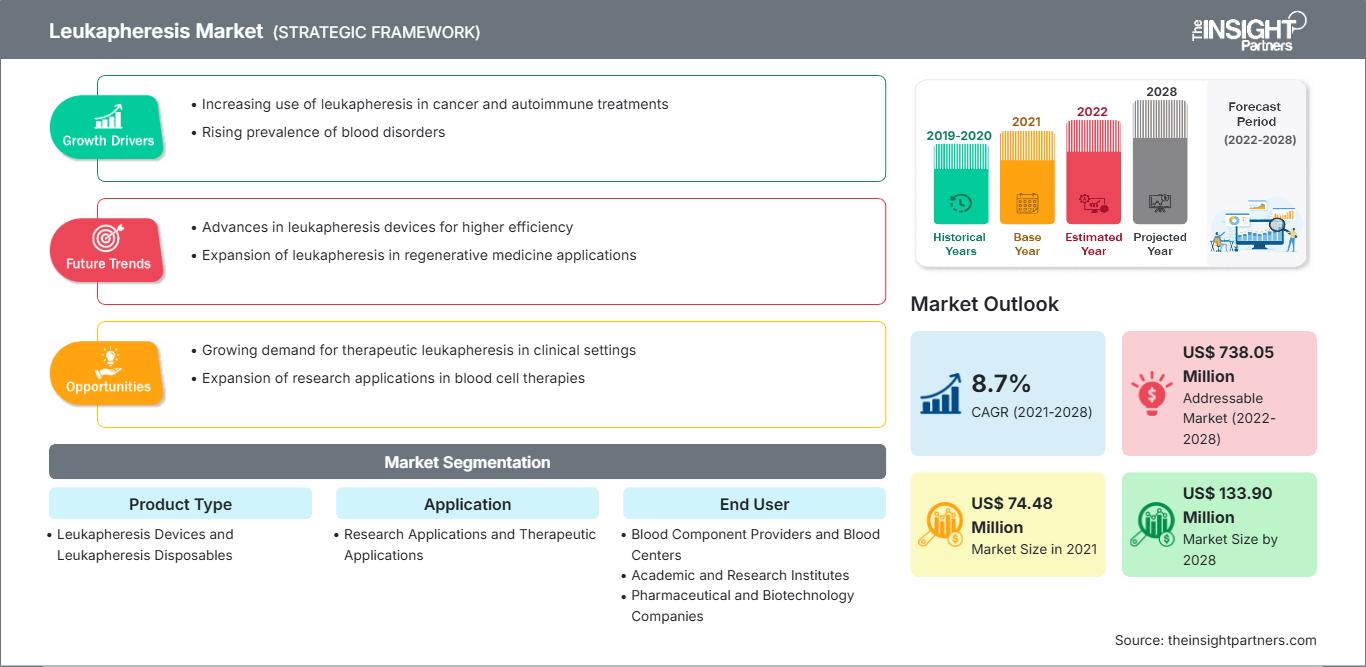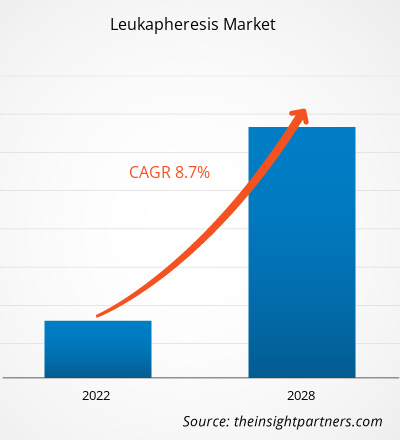[Rapporto di ricerca]Si prevede che il mercato della leucaferesi raggiungerà i 133,90 milioni di dollari entro il 2028, rispetto ai 74,48 milioni di dollari del 2021; si stima una crescita a un CAGR dell'8,7% dal 2021 al 2028.
La leucaferesi è una procedura che prevede la separazione dei globuli bianchi (leucociti) coinvolti nella risposta immunitaria dell'organismo da un campione di sangue. Si tratta di una particolare forma di aferesi in cui una parte del sangue, come globuli rossi o piastrine, viene prelevata mentre il sangue rimanente viene reimmesso in circolazione. La leucaferesi viene spesso utilizzata per ridurre conte leucocitarie (WBC) molto elevate, come nei tumori del sangue cronici come la leucemia linfatica cronica (LLC). Può anche essere eseguita per ottenere globuli bianchi per un successivo trapianto, ad esempio per gestire bruschi cali nella conta dei WBC durante la chemioterapia antitumorale. Un altro utilizzo è come componente di una nuova forma di immunoterapia, denominata terapia con cellule T con recettore antigenico chimerico (CAR), per contribuire a combattere la leucemia, il cancro alla prostata e altre forme di cancro. La leucaferesi può essere eseguita sulla persona che richiede il trattamento (aferesi autologa) o su un donatore per un successivo trapianto (aferesi allogenica). Attualmente, la leucaferesi è comunemente utilizzata per trattare diverse patologie e viene utilizzata anche a scopo diagnostico in quanto può aumentare la resa di cellule tumorali circolanti. Fattori come il crescente numero di donatori di sangue volontari, l'aumento dell'incidenza di malattie ematologiche e l'aumento della popolazione anziana stanno alimentando la crescita del mercato della leucaferesi. Tuttavia, l'elevato costo della leucaferesi ne ostacola in una certa misura la crescita.
Personalizza questo rapporto in base alle tue esigenze
Potrai personalizzare gratuitamente qualsiasi rapporto, comprese parti di questo rapporto, o analisi a livello di paese, pacchetto dati Excel, oltre a usufruire di grandi offerte e sconti per start-up e università
Mercato della leucaferesi: Approfondimenti strategici

-
Ottieni le principali tendenze chiave del mercato di questo rapporto.Questo campione GRATUITO includerà l'analisi dei dati, che vanno dalle tendenze di mercato alle stime e alle previsioni.
La trasfusione di sangue è parte integrante dell'infrastruttura e delle politiche sanitarie nazionali di diversi paesi. I progressi nel settore medico hanno portato a miglioramenti nelle procedure di trattamento di malattie e lesioni gravi, il che ha infine aumentato la necessità di trasfusioni di sangue per la sopravvivenza dei pazienti. La crescente consapevolezza dell'importanza della trasfusione di sangue e della disponibilità di sangue nei servizi sanitari ha portato a un aumento del numero di persone disposte a donare il proprio sangue per cause mediche. Secondo i dati dell'Organizzazione Mondiale della Sanità (OMS), nel 2018 sono state segnalate circa 117,4 milioni di donazioni di sangue in tutto il mondo. I donatori di sangue sono generalmente classificati in volontari non retribuiti, retribuiti e familiari/sostitutivi e, secondo l'OMS, i donatori volontari/non retribuiti sono la principale fonte di un approvvigionamento di sangue affidabile e adeguato. Secondo i dati dell'OMS del 2019, le donazioni di sangue da parte di donatori volontari non retribuiti sono aumentate di 11,6 milioni dal 2008 al 2015 in 139 paesi del mondo. La tendenza alla donazione di sangue sta acquisendo notevole importanza anche nei paesi a basso e medio reddito. Secondo i dati presentati durante la riunione annuale del CAG del 2017, nel 2016 sono state eseguite circa 13.000 procedure su 1.087 pazienti. Il maggiore aumento del numero di donatori di sangue volontari si è registrato nei paesi del Sud-est asiatico (83%) e nelle Americhe (70%).
I programmi nazionali sviluppati e implementati in molti paesi stanno ulteriormente attraendo un gran numero di donatori di piastrine e sangue. Ad esempio, in India, il National Blood Transfusion Council (NBTC), costituito all'interno della National AIDS Control Organization (NACO), è l'organismo centrale che si coordina con i Consigli Trasfusionali Statali (SBTC), istituiti all'interno delle Società Statali per il Controllo dell'AIDS (SACS). Il NBTC supporta programmi sanitari per varie attività relative ai servizi trasfusionali (BTS). Pertanto, il crescente numero di donatori idonei in diversi paesi del mondo sta aumentando la necessità di apparecchiature per leucaferesi utilizzate per separare i componenti del sangue necessari.
Approfondimenti basati sulla tipologia di prodotto
In base alla tipologia di prodotto, il mercato della leucaferesi si divide in dispositivi per leucaferesi e materiali monouso per leucaferesi. Nel 2021, il segmento dei materiali monouso per leucaferesi deteneva una quota di mercato maggiore. Tuttavia, si prevede che il segmento dei dispositivi per leucaferesi registrerà un CAGR più elevato nel periodo 2021-2028.
Approfondimenti basati sull'applicazione
Il mercato della leucaferesi, per applicazione, si divide in applicazioni di ricerca e applicazioni terapeutiche. Nel 2021, il segmento delle applicazioni di ricerca ha detenuto una quota di mercato maggiore e si prevede che lo stesso segmento registrerà un CAGR più elevato nei prossimi anni.
Approfondimenti basati sull'utente finale
Il mercato della leucaferesi, per utente finale, è segmentato in aziende farmaceutiche e biotecnologiche, istituti accademici e di ricerca, fornitori di emocomponenti e centri trasfusionali, ospedali e centri trasfusionali. Nel 2021, il segmento dei fornitori di emocomponenti e dei centri trasfusionali ha detenuto la quota di mercato maggiore. D'altro canto, si prevede che il segmento degli ospedali e dei centri trasfusionali registrerà il CAGR più elevato nei prossimi anni.
Le aziende che operano nel mercato della leucaferesi stanno adottando strategie come lanci di prodotti, fusioni e acquisizioni, collaborazioni, innovazioni di prodotto ed espansioni del portafoglio prodotti per espandere la propria presenza a livello mondiale, mantenere il marchio e soddisfare la crescente domanda degli utenti finali.
Approfondimenti regionali sul mercato della leucaferesi
Le tendenze regionali e i fattori che influenzano il mercato della leucoaferesi durante il periodo di previsione sono stati ampiamente spiegati dagli analisti di The Insight Partners. Questa sezione illustra anche i segmenti e la geografia del mercato della leucoaferesi in Nord America, Europa, Asia-Pacifico, Medio Oriente e Africa, America Meridionale e Centrale.
Ambito del rapporto di mercato sulla leucaferesi
| Attributo del rapporto | Dettagli |
|---|---|
| Dimensioni del mercato in 2021 | US$ 74.48 Million |
| Dimensioni del mercato per 2028 | US$ 133.90 Million |
| CAGR globale (2021 - 2028) | 8.7% |
| Dati storici | 2019-2020 |
| Periodo di previsione | 2022-2028 |
| Segmenti coperti |
By Tipo di prodotto
|
| Regioni e paesi coperti |
Nord America
|
| Leader di mercato e profili aziendali chiave |
|
Densità degli operatori del mercato della leucaferesi: comprendere il suo impatto sulle dinamiche aziendali
Il mercato della leucoaferesi è in rapida crescita, trainato dalla crescente domanda degli utenti finali, dovuta a fattori quali l'evoluzione delle preferenze dei consumatori, i progressi tecnologici e una maggiore consapevolezza dei benefici del prodotto. Con l'aumento della domanda, le aziende stanno ampliando la propria offerta, innovando per soddisfare le esigenze dei consumatori e sfruttando le tendenze emergenti, alimentando ulteriormente la crescita del mercato.

- Ottieni il Mercato della leucaferesi Panoramica dei principali attori chiave
- Dispositivi per leucaferesi
- Dispositivi per aferesi
- Colonne per leucaferesi e separatori cellulari
- Filtri per leucodeplezione
- Materiali monouso per leucaferesi
Mercato della leucaferesi - per applicazione
- Applicazioni di ricerca
- Applicazioni terapeutiche
Mercato della leucaferesi - per utente finale
- Aziende farmaceutiche e biotecnologiche
- Istituti accademici e di ricerca
- Fornitori di componenti del sangue e centri trasfusionali
- Ospedali e centri trasfusionali
Mercato della leucaferesi - per tipo di prodotto
- Dispositivi per leucaferesi
- Colonne per leucaferesi e separatori cellulari
- Filtri per leucaferesi
Mercato della leucaferesi - per applicazione
- Applicazioni di ricerca
- Applicazioni terapeutiche
Mercato della leucaferesi - per utente finale
- Aziende farmaceutiche e biotecnologiche
- Istituti accademici e di ricerca
- Fornitori di componenti del sangue e centri trasfusionali
- Ospedali e centri trasfusionali
Mercato della leucaferesi - per tipo di prodotto
- Aziende farmaceutiche e biotecnologiche
- Istituti accademici e di ricerca
- Fornitori di componenti del sangue e centri trasfusionali
- Ospedali e centri trasfusionali
Mercato della leucaferesi per area geografica
-
America settentrionale
- Stati Uniti
- Canada
- Messico
-
Europa
- Francia
- Germania
- Italia
- Regno Unito
- Spagna
- Resto d'Europa
-
Asia Pacifico (APAC)
- Cina
- India
- Corea del Sud
- Giappone
- Australia
- Resto dell'Asia Pacifico
-
Medio Oriente e Asia. Africa (MEA)
- Sudafrica
- Arabia Saudita
- Emirati Arabi Uniti
- Resto del Medio Oriente e dell'Africa. Africa
-
Sud America (SAM)
- Brasile
- Argentina
- Resto del Sud e Centro America
Profili aziendali
- Asahi Kasei Corporation
- Fresenius SE & Co. KGaA
- Haemonetics Corporation
- Terumo Corporation
- STEMCELL Technologies Inc.
- HemaCare
- Macopharma
- AllCells
- STEMEXPRESS
- BioIVT
- Analisi storica (2 anni), anno base, previsione (7 anni) con CAGR
- Analisi PEST e SWOT
- Valore/volume delle dimensioni del mercato - Globale, Regionale, Nazionale
- Industria e panorama competitivo
- Set di dati Excel
Report recenti
Testimonianze
Motivo dell'acquisto
- Processo decisionale informato
- Comprensione delle dinamiche di mercato
- Analisi competitiva
- Analisi dei clienti
- Previsioni di mercato
- Mitigazione del rischio
- Pianificazione strategica
- Giustificazione degli investimenti
- Identificazione dei mercati emergenti
- Miglioramento delle strategie di marketing
- Aumento dell'efficienza operativa
- Allineamento alle tendenze normative






















 Ottieni un campione gratuito per - Mercato della leucaferesi
Ottieni un campione gratuito per - Mercato della leucaferesi